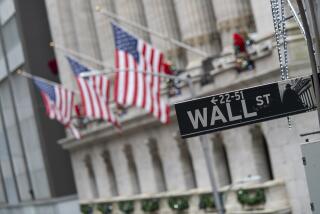Big Board’s Extended Day Gets Off to Slow Start
- Share via
NEW YORK — The New York Stock Exchange’s bid to recapture business lost to foreign exchanges and other markets got off to a slow start on Thursday, as only 2.33 million shares were traded in the inaugural pair of electronic sessions after the Big Board’s 4 p.m. closing bell.
“This is a tiny first step in the onward march towards a continuous 24-hour-a-day market,” said Richard A. Grasso, president and executive vice chairman of the NYSE.
While pronouncing the results of the two special sessions “right on target,” Grasso said Thursday’s activity “is by no means indicative of the success or failure” of the program.
The 2.33 million shares traded in the after-hours sessions represented about 1.6% of the day’s total volume of 147.20 million shares. About 270 different stocks changed hands in the special sessions.
One session, for trading individual stocks, ran 45 minutes and the second, for trading “baskets” of stocks typically exchanged by professional program traders, lasted an hour and 15 minutes.
Echoing Grasso, traders cautioned that it will take time to determine the ultimate success of the two-year experiment, which was designed to bring back to the NYSE about 15 million to 20 million shares in daily volume that now takes place overseas or on regional exchanges.
“There wasn’t any avalanche of orders waiting to flow through in the first session,” said Tony Cecin, head of equity trading at Piper, Jaffray & Hopwood Inc. in Minneapolis. None of the five retail orders that the firm entered into the NYSE’s computers were executed, he said, because of Big Board rules requiring the matching of buy and sell orders after hours.
In this respect, the after-hours trading differs markedly from the chaotic price-setting auction-style trading during the Big Board’s regular 9:30 a.m. to 4 p.m. trading day.
The throngs of traders and specialists whose frenetic activity is standard footage on the evening news left the Big Board’s cavernous trading hall as usual at 4 p.m., leaving behind a small handful who pecked away at computer terminals. There was no bargaining on price; under exchange rules, the price for after-hours trades on the NYSE was the price at which the shares closed at 4 p.m.
Eric Fisher, a vice president with the College Retirement Equities Fund, said the first day of after-hours trading “looked pretty good.” He said the pension fund placed buy or sell orders for 28,000 shares in 14 stocks, and 40% were executed.
In all, 737,700 shares were traded during what the exchange called “crossing session 1” for individual stocks and 1,560,990 were traded during “crossing session 2” for baskets of at least 15 NYSE stocks. Grasso said it was too early to say what percentage of orders were filled.
Leslie Quick Jr., chairman of discount broker Quick & Reilly Inc., predicted that after-hours volume might surge on days featuring extreme price swings during the final hour of regular trading.
But the head trader at one big Wall Street firm said he doubts that the NYSE’s program will catch on. “I don’t see this as a big event or as anything new,” he said, noting that after-hours trading has been available for many years both overseas and elsewhere.
Still, Robert McCann, head of listed equity trading at Merrill Lynch, said “this is the first system that lets individuals as well as institutions participate.”
NYSE After-Hours Trading
The New York Stock Exchange began after-hours trading on Thursday. The move is part of a wider plan to implement 24-hour trading by the end of the decade. Here’s how it works:
4:00: NYSE closes
4:00-5:15 p.m.: Crossing Session II Baskets of stocks traded. They must contain at least 15 NYSE-listed stocks with value of $1 million or more.
4:15-5:00 p.m.: Crossing Session I Traders place orders to buy or sell individual stocks at NYSE closing prices, or enter prearranged trades.
4:30: Pacific Stock Exchange closes
5:00: Orders are matched up and executed. Unfilled orders are carried over until the following day.
5:20-6:00 p.m.: Transmission of final stock data.
More to Read
Inside the business of entertainment
The Wide Shot brings you news, analysis and insights on everything from streaming wars to production — and what it all means for the future.
You may occasionally receive promotional content from the Los Angeles Times.










